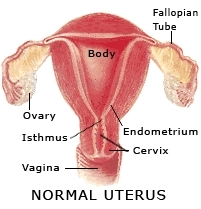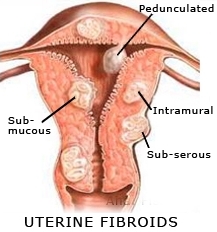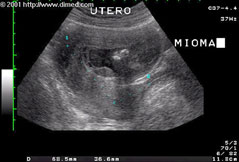Uterine Fibroids
What are uterine fibroids?
Uterine fibroids are a non-cancerous growth in the uterine wall, ranging in size from microscopic to the size of a grapefruit.
What happens in the body?
Fibroids are round and firm lumps often in groups located in the walls of the uterus. They are made of muscle fibers and fibrous tissue. They respond to an increase in estrogen levels, which is one of the female hormones. An increase in hormonal values will result in accelerated growth of the fibroid.
This occurs in cases of:
- Hormone replacement therapy in menopause
- Use of contraceptives
- Pregnancy
After menopause, fibroids may shrink or disappear completely
What are the causes and risks?

The exact cause of fibroid formation is not known. Studies have shown that their growth is influenced by factors:
* Genetics as an important factor in the development of fibroids.
* They occur more frequently during the reproductive period when there is an increase in blood supply to the uterus.
* Estrogen and Progesterone, which are female hormones, seem to stimulate their growth. It has been observed that fibroids have more receptors for estrogen and progesterone.
Risk factors include:
* Heredity: especially if a mother or sister has fibroids.
* Racial Factor: black women suffer 3 times more, as well as larger size and number of fibroids than white women.
Signs and symptoms
Many women may not have any signs of the presence of fibroids. Symptoms depend on their number, size, and location:
- The number can range from one to several.
- Sizes vary from microscopic to the size of a grapefruit.
- Location can be superficial, internal, or intramural (as in the figure)

Symptoms:
- Anemia, or a decrease in the number of red blood cells as a result of prolonged and heavy bleeding
- Intermenstrual bleeding
- Pain during sexual intercourse
- Frequent urination caused by the pressure the tumor places on the bladder
- Heavy and prolonged menstrual periods
- Pain or pressure in the lower abdomen or back pain
- Painful menstrual cycles
Diagnosis & Tests
Fibroids are common in women over 35 years old. Rarely are they malignant or cancerous. Fibroids that grow on the outer surface of the uterus can be felt as lumps during a pelvic exam. Whereas fibroids that grow inside the uterus are harder to detect during this exam.
The diagnosis is confirmed through ultrasound examination. Rarely dilation and curettage (D&C) may be needed to take tissue samples from the inside of the uterine cavity.
The entirety of the uterine cavity is examined through Hysteroscopy, to exclude the existence of uterine cancer or endometrial polyps. Magnetic resonance imaging provides accurate dimensions, location, and helps in determining the method of treatment.
Prevention:
Since the causes of their formation are not known, there is no way to prevent their development.
What are the consequences?- The presence of Fibroids can make conceiving a child more difficult
- During pregnancy, they can cause miscarriages or complications during childbirth
- Fibroids can twist and may require surgical intervention
- Fibroids are not contagious
- Fibroids can pose a risk to the fetus during pregnancy.
Treatment & Monitoring

Most fibroids do not cause symptoms and therefore do not need treatment.
Medications are often used to reduce the tumor by lowering estrogen levels in the blood such as GNRH agonists, androgens, nonsteroidal anti-inflammatory.
Women with heavy prolonged bleeding leading to anemia and not controllable by medication should undergo surgical intervention, which depending on the desire to have children can range from removal of only the fibroid to removal of the entire uterus.
If the fibroid is located in the uterine cavity, its removal can be done with a resectoscope, via the vaginal route.
Another procedure that can be used is arterial embolization during which a tube is placed in the uterine artery and small beads are injected that go towards the tumor. These block the flow in the target artery leading to shrinkage of the fibroid.
Treatment with laser, or MIOLYSIS, is another procedure that destroys the fibroid. 3-4 months prior, the woman should take some medications that cause the tumor to shrink and then laser treatment is done.
What are the side effects of treatment?
Surgical intervention carries the risk of bleeding, infections, or allergic reactions from anesthesia.
What happens after treatment?
If a hysterectomy is performed, there is no more risk of developing another fibroid.
If the ovaries are removed during the surgery, hormone replacement therapy should continue.
If a myomectomy (removal of only the fibroid) is performed, in about 10% of cases, there is further growth
How is monitoring done?
Women with fibroids should be examined every 6 months to monitor the size of the tumor and the blood circulation within it, as well as the appearance of various symptoms.
Hello, the article is very understandable but I have a question: if the fibroid is 10 cm in diameter, besides surgical intervention, can it be reduced with medication, meaning with drugs????
Sent by lindita, më 29 July 2013 në 15:21
Hello. I congratulate you on the column. I am 44 years old. I wanted to know what should be done in the case when a fibroid, attached to the outside wall of the uterus, was removed 6 years ago and now has formed again, attached to the outer wall of the uterus. The dimensions are 8cm by 6cm. Should another operation be done? If yes, should only the fibroid be removed as last time, or should the uterus be removed as well? In this case, I do not have bleeding, but I have severe menstrual pain. Thank you
Sent by berta, më 22 December 2013 në 13:09
Hello, thank you for the information. If the fibroid is very small, can its growth be stopped with medication?
Sent by grgrgrg, më 14 January 2014 në 08:58
Hello, I congratulate you on your section. My wife has 5 uterine fibroids in the uterus muscles. I want to ask, she is 42 years old and we don't have children. She has had two miscarriages. She wants to try in vitro. What are the chances of getting pregnant and maintaining the pregnancy with these 5 fibroids? Best regards
Sent by selami asani , më 16 November 2014 në 05:46
Congratulations on the topic, it is very well explained
Sent by Enver Elezi, më 09 December 2014 në 12:07
Very accurate explanation, thank you, but is this problem the same as what I have heard from doctors (uterine fibroids)? I'm asking for my mom
Sent by Fabion bajrami, më 06 July 2015 në 01:09
My name is Melita. I am 42 years old and have been diagnosed with six (6) fibromyomas of considerable size, from the largest at 85 mm to the smallest at 20 mm, which are Intramural and Submucosal. What solution do you think would be best considering my age as well?
Sent by Melita Dorez, më 27 October 2016 në 10:36
Good evening Melita! The way of solving depends not only on the dimensions and location but also on the concerns you have. Given the young age, there is certainly a possibility that they may grow or increase in number. For this reason, you should always be under the doctor's supervision. If the fibroids are as large as you say, it would be best to remove them if possible. If it's impossible to remove them due to their spread, but at the same time they cause problems like pain or bleeding, then removing the uterus could be considered. Anyway, decisions are made together with the doctor who is treating you!
Replay from Kozeta Mustafaraj, më 27 October 2016 në 14:25
Hello! My name is Ela and I am 29 years old. After a visit to the Gynecologist for a routine check-up, the doctor informed me that I have a Fibroid measuring 2.8 cm by 3 cm. I am planning to get pregnant during this period. Can the Fibroid cause problems for pregnancy? Thank you
Sent by Ela, më 11 November 2016 në 02:44
Good afternoon Ela. The impact of fibroids on pregnancy depends on their location. If it is on the outer surface or inside the wall, it does not have any impact. If it is located near the fallopian tube openings, it may cause problems with becoming pregnant. If it is in the inner layer, it may cause problems during pregnancy
Replay from 0 Kozeta Mustafaraj, më 11 November 2016 në 03:55
Thank you very much for your response. The fibroid is 2.8 cm * 3 cm in the Cervix. Could it be a bigger problem? Thank you again
Sent by Ela, më 11 November 2016 në 05:26
Only the doctor who performs the ultrasound and sees the location and connections with the other parts of the genital apparatus can answer this question
Replay from 0 Kozeta Mustafaraj, më 11 November 2016 në 07:34
I have a node in the uterus and it is located next to the urinary bladder. And cysts on the ovaries. I have severe pain. Frequent urination. Pain at the bottom of the abdomen and numbness in the right leg in the pelvic area. Often there is also bleeding. Thank you
Sent by Silvana veshaj , më 08 December 2016 në 11:37
Good afternoon! All these are complaints... But what is the question?
Replay from Dr. Kozeta Mustafaraj, më 09 December 2016 në 05:52
Hello! I am 29 years old, and I have been diagnosed for two years with two intramural fibroids in the uterus, one measuring 7 cm and the other 5 cm. From the examinations I have done, I also have a blocked fallopian tube. I have been trying to get pregnant for over two years but with no result, I don't know what to do? Should I wait more? Should I undergo surgery? Or try IVF? Waiting for an answer. Thank you!
Sent by Ona, më 21 February 2017 në 22:09
Good evening, Ona.
It's not possible to simply give an opinion based on the size of the fibroids. It's difficult. It depends on you and your doctor what you will do.
Of course, you can have the surgery to remove the fibroids, and then wait at least one year before trying to get pregnant.
If you don't get pregnant naturally, you can try in vitro fertilization
Replay from Dr. Kozeta Mustafaraj, më 26 February 2017 në 12:03
Hello, I have been diagnosed with a nodule in the uterine wall measuring 6×5cm. Please tell me what risk it poses and whether I need to have it removed
Sent by ani, më 16 March 2017 në 13:58
Hello Ani. Fibromyoma does not pose a risk to life. It is a pathology very widespread around the world. Whether it needs to be removed or not depends on the position where it is located, the discomfort it causes, and the state of its internal blood circulation. This is decided by the doctor who is following up with you and, of course, by yourself
Replay from Dr. Kozeta Mustafaraj, më 27 March 2017 në 14:39
I am a 35-year-old woman and it has been a week since I had 3 large fibroids removed, each measuring 10 cm, through laparoscopy. I feel good now, even though I received 6 blood transfusions during the surgery because I was anemic. I wanted to ask you how long I should wait before having sexual intercourse with my husband and when I can try for another baby. I hope to receive an answer from you, thank you. I follow your advice and it is very valuable
Sent by Iira, më 27 April 2017 në 04:02
Hello Lira. You can have sexual relations whenever you want. It does not depend on the surgery, but on your condition, if you are in pain wait another week. Meanwhile, you should continue taking the medication for anemia, for at least 3 months. And then you can try to get pregnant. I wish you a speedy recovery
Replay from Dr. Kozeta Mustafaraj, më 27 April 2017 në 14:31
Hello! I am only 23 years old, I have never given birth, and I have been diagnosed with a 14 cm fibroid. What kind of surgery is most suitable that will not damage the uterus and will allow me to have children?
Sent by Ana , më 17 Agust 2017 në 02:42
Hello Ana.
The type of intervention is determined by the doctor who is treating you. He knows the location of the fibroid, its connections with the surrounding tissues, and the tools he has available
Replay from Dr. Kozeta Mustafaraj, më 31 Agust 2017 në 14:28
I am 38 years old, I don't have children and have been diagnosed with a 12-14cm fibroid located on the right side of the uterus. The doctor told me that the entire uterus needs to be removed. Please, can you give me your opinion on whether there is any possibility of not removing the uterus because I want to have a child in the future?
Sent by Dita, më 27 January 2018 në 13:27
Hello Dita.
If the fibroid is that big, of course, it needs to be removed. As for the uterus, I can't say anything, as this depends on factors that only the doctor who has examined you can determine
Replay from Dr. Kozeta Mustafaraj, më 20 February 2018 në 14:36
Hello to you...
Just operated on for a fibroid measuring 12-10.
I suffered from pronounced anemia after the procedure.
Hemoglobin was 12 before and 6.2 after leaving the operating room...
What worries me more is a 4-day temperature at 38.4... and at the same hour.
How risky are these two components???
Sent by Mimoza, më 24 November 2018 në 12:55
Hello Mimosa,
You need to take medicine for anemia, and everything will pass, do not worry.
Eat well and take your medicine regularly!
Replay from Dr. Kozeta Mustafaraj, më 05 December 2018 në 09:51
I am 46 years old and today I had a visit to the gynecologist, from the ultrasound because when I have my period, I have a lot of pain and bleeding, I feel very tired, it turned out that I have a 4 cm fibroid and he advised me to have surgery. I am in doubt because I am afraid. I live in Luxembourg and I don't know what to do
Sent by Aida Saliaj, më 03 December 2018 në 16:03
Hello Aida!
If the doctor has told you to have surgery, they have considered it necessary.
I am not in a position to decide for you, as I don't know what grade your fibroid is, and how it can be treated.
You could seek the opinion of another doctor there, who could examine you and give you the proper advice!
Replay from Dr. Kozeta Mustafaraj, më 05 December 2018 në 09:25
Hello, it's been 3 weeks since I had my uterus and right ovary removed. This morning I noticed a slightly darker brown discharge. Should I be worried? This has also happened to me after the surgery
Sent by Eva, më 27 June 2019 në 07:47
Hello. It is possible to have brown discharge during this period, but if you notice that it increases or you have a fever, or the discharge has a bad smell, you should have a gynecological check-up
Replay from Dr. Kozeta Mustafaraj, më 28 June 2019 në 07:19
Hello! Two weeks ago I was diagnosed with 2 fibroids in the uterus. The doctor determined they were smaller than 2 cm each. I was given medication because I have increased flow during my cycle and brown spots even after the 12th day or more of the cycle. I also have hormonal disorder (tests showed this) of 2 cycle hormones. They are very low (4). I have back and leg pain as well as sickle cell anemia. The doctor prescribed me Diane 35, however, the instruction leaflet of this medication wrote that those with my type of anemia should not take this kind of medication. What should I do?
Sent by Deni, më 27 July 2019 në 17:23
Hello Deni.
In your case, you need to consult with the hematologist who is treating you, and it is they who decide whether you can take it or not. Have a good day
Replay from Dr. Kozeta Mustafaraj, më 30 July 2019 në 04:21